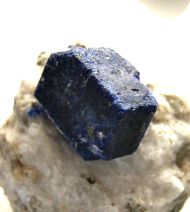 |
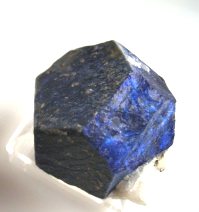 |
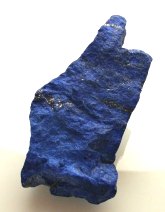 |
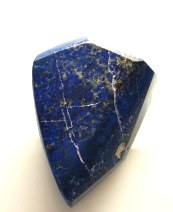 |
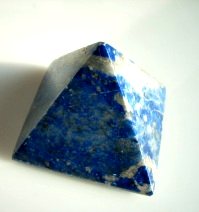 |
|
青金石結晶(lazurite crystal) |
黄鉄鉱を伴う青金石 |
研磨された青金石 |
ラピスラズリ工芸品 | |
ラピスラズリ(Lapis-lazuli)
1 名前と歴史について (about name and history)
 |
 |
 |
 |
 |
|
青金石結晶(lazurite crystal) |
黄鉄鉱を伴う青金石 |
研磨された青金石 |
ラピスラズリ工芸品 | |
|
Lapis-lazuli |
結晶系 |
化学組成 |
モース硬度 |
比重 |
屈折率 | |
|
青金石 |
Lazurite |
等軸晶系 |
(Na,Ca)8(S,SO4,Cl)2(AlSiO4)6 |
5〜5½ |
2.38-95 |
1.50 |
|
方ソーダ石 |
Sodalite |
等軸晶系 |
Na8Cl2(AlSiO4)6 |
5½〜6 |
2.14-40 |
1.483-487 |
|
ノゼアン |
Nosean |
等軸晶系 |
Na8SO4(AlSiO4)6 |
5〜6 |
2.3-4 |
1.48-495 |
|
藍方石 |
Haüyne |
等軸晶系 |
(Na,Ca)4-8(SO4)1-2(AlSiO4)6 |
5〜6 |
2.4-5 |
1.496 |
| 天藍石 | Lazulite | 単斜晶系 (Monoclinic) |
(Mg,Fe2+)[Al2(PO4)2](OH)2 | 5〜6 | 3.09 | 1.612-643 |
名前について(about Name)日本語では古くから瑠璃と呼ばれていましたが、ラピスラズリとは宝石名です。
ラピスとはラテン語で石のことです。そして古いペルシア語で青を意味する "ladjevard" からアラビア語の "lazul" を経て6世紀頃のラテン語に "lazurium" となって入った形容詞が付いて青い石を意味する "lapis-lazuli" が使われるようになりました。
しかしこの名前に至るまで数々の変遷がありました。
ギリシアのテオフラステス (BC.372-287) やローマ時代に大プリニー (23-79), さらにドイツのアグリコーラ (1494-1555) がサファイアと呼び、”金色の星々が煌めく蒼穹” と形容していた宝石が実は金色の黄鉄鉱を含むラピスラズリであったことは間違いありません。
5世紀以降、ラピスラズリはヨーロッパでウルトラマリン (ultramarinum : 海の彼方) とも呼ばれていました。海の彼方、即ち遠い異国からもたらされる貴重な宝石であり、これを手にすることが出来たのは強大な権力と財力を持つ王族や教会のみでした。
Lapis-lazuli is not a mineral name, but a gemstone name, meaning blue stone. "Lapis" means stone and "lazuli" means blue in Latin. Then around 6th centuries in Europe, ancient Persian origin word "ladjevard" meaning blue came into Latin via Arabic word "lazul" as "lazurium" Before lapis-lazuli name came into Europe, in Greek and in Rome, this gemstone has been called in various names ; A gemstone called "Sapphirus" by Theophrastus(B.C. 372-287), Pliny the Elder(23-79) and German mineralogist Agricola(1494-1555) and being described as "sky constelled with satrs, or like blue thing pointed with gold" is surely lapis-lazuli. After 5th century, this stone has been called in the name of "ultramarinum : beyond the sea", too, suggesting that, it came from far country beyond the sea. Therefore it was extremely precious stone and only kings and princes, and churche could afford to get it.
宝石としてラピスラズリと呼ばれますが、鉱物としてはラズライト (Lazurite) が正式な名前です。
その名のとおり、ラテン語の青 : lazurium に因む名前ですが、日本語では金色の黄鉄鉱を含む青い石、青金石 (せいきんせき) と名づけられています。
さて、鉱物名と宝石名とが異なるのは珍しいことではありません。
例えば鋼玉 (コランダム) の赤は紅玉 (ルビー)、それ以外の色は全てサファイア、また緑柱石 (ベリル) の青い色はアクアマリン、緑〜金色はヘリオドール、ピンクがモルガナイト、エメラルド・グリーンがエメラルドと、不純物による色変わりで多くの宝石名が生まれます。
ところで青金石が宝石のラピスラズリとなるのは少し事情が異なります。
Lazurite, derives from Latin "lazurium" is the mineral name. As in case of ruby ans sapphires, which mineral name is corundum, or beryls in various colors, minerals are often called in different names, mainly depending on color variations.
But azurite, which gemstone name lapis-lazuli has a little complicated story ;
|
|
 |
 |
| 上(top):ソーダライト(Sodalite) Bancroft, Canada |
石英中の天藍石(lazulite in quartz) |
稀に見る大きな天藍石 5.85ct 10.6x10.1x6.12mm Extremely rare facetted lazulite |
| 右(right): ノゼアン(Nosean) Laacher See, Germany | ||
| 左(left):アウイン(Haüyne) Niedermendig, Germany |
実はラピスラズリとは青金石に似た化学組成を持つ同じ結晶系の方ソーダ石族のソーダライト、ノゼアン、アウインとの固容体として産出する宝石です。
これらの鉱物はいずれもアルミニウムまたは珪素を4つの酸素が囲む4面体が立体的につながった骨組みを作っています。
この骨組みの間に比較的に大きな空間があって、様々な異なるイオンが入ることで少しづつ組成の異なる同族の鉱物が生まれます。
例えばソーダライトではナトリウムと塩素イオンが、ノゼアンではナトリウムと4酸化硫黄が、青金石ではナトリウム、カルシウムと硫黄、4酸化硫黄と塩素が入っています。
青金石の紺青は含まれる硫黄のイオンによる発色です。
こうした同じ構造をとる同族の鉱物では大きさや性質が似たイオンの一部が置き換えられことがあり、固容体と呼ばれる状態になります。
柘榴石族や長石族等、多くの鉱物グループも大半は固容体として産出します。
単に雑多な鉱物の混合物であれば決して結晶にはなりませんが、冒頭の写真の例のように固容体は見事な結晶となります。
青金石の結晶はかつては大変珍しく高価なものでしたが、最近では豊富に出回るようになって値段も手ごろな水準となりました。
Lapis-lazuli is recovered always as solid solution of lazurite with similar chemical composition minerals of sodalite group, sodalite, noseane and haüyn. These minerals have same structure formed with alminium or silicone are surrounded with series of tetrahedra formed by four oxigen atoms. This structure has vacant space big enough where different ions occupies to form a group of minerals with slightly different components ; sodalite(Na and Cl ions), noseane(Na and SO4), lazurite(Na,Ca, S and SO4, Cl). The heavenly blue color of lazurite derives from sulfer ion trapped in the tetrahedra structure.
In these minerals of same group, a part of ions with similar dimentions and natures are often replaced each other to form crystal of mixed components called, solid solution, as often shown in garnet, feldspar group and other minerals groups in the nature. Solid solution is not a mixture of different minerals but a fusion of minerals in the same group, therefore is found as crystal in the nature. Lazurite crystal was rare and expensive in the past, but today is recovered abundant.
ラピスラズリの場合はこれらの固容体に加えて母岩の方解石や、さらに黄鉄鉱が不純物として混ざってきます。
白い方解石は宝飾用途には邪魔者となりますが、紺青の地に金色の彩を加える黄鉄鉱の方は、むしろ,えも言われぬ美しい風情を加えるため却って価値を高める存在として高く評価されます。
和名で青金石と命名された所以です。
長くなりましたが、即ちラピスラズリとは、青金石を主成分とする方ソーダ石族の鉱物との固容体に、さらに母岩の方解石や不純物である黄鉄鉱が混ざった美しい石の宝石名です。
注意しなければならないことは、宝石の本にしばしば青金石 (lazurite) と天藍石 (lazulite) とが混同されて記載されていることです。
石灰岩の変成鉱床に生成する青金石と、ペグマタイトの変成石英脈中に産する天藍石とでは産状も化学組成も様々な特性も異なります。
しかしながら、まずは英語の名前と綴りが混乱の元である上に、色合いも青金石の紺青と天藍石の藍色とは良く似ていて紛らわしく、その上両者共に装飾用に使われるためしばしば混同されているのが現状です。
”新宝石辞典” の久米武夫、"宝石” の近山晶、"宝石の写真図鑑” の監修者の砂川一郎といった、代表的な宝石学者や専門家がいずれも単純な勘違いからでしょう、青金石と天藍石とを混同している程です。
斯く言う私自身、ラズライト( Lazulite : 天藍石 )の透明なファセット石を見た時に、てっきりラズライト( Lazuite : 青金石 )の透明な結晶が出現したのかと思わず興奮してしまいました。
この二つが実は全く異なる鉱物と分かったのはずいぶん後のことです。
天藍石は通常は1カラット以下の小さなファセット級のものがブラジルと、最近ではナミビアから稀に採れます。 写真の石は産地不明ですが、5カラットを超える記録的な大きさです。
A lazurite recovered mixed with impure inclusions such as calcite and pyrite is called lapis-lazuli, as gemstone. White calcite is nothing but an unfavarable impurity, while occasional golden flecks of pyrite inclusion is highly appreciated that distinguish the most desirable lapis-lazuli.
One thing to note is lazurite and lazulite are often confused, in genral. Although their occurence, composition and properties are different, confusiong name and spelling, similar blue color and use as ornamental stone are the cause of confusions.
I myself also mistook lazulite facetted stone as transparent lapis-lazuli and did not realize the misapprehension
for long time.
歴史について(History)

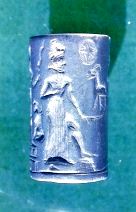
雄山羊像 42.6cm
The statue of a goat
B.C.2500 Ur, Sumerラピスラズリ、トルコ石、瑪瑙等の首飾り B.C.16century
Neck adornment of lapis-lazuli, turquoise, agate, etc.
Tutankhamen Museum, Cairo円筒印 B.C. 1800
Cylinder Seal
Babylonia
スカラベの腕輪
エトルリア B.C.500
Scarabe Bracelet
Etruria

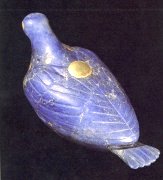

リュトン(角状盃) 48cm
ペルシア アケメネス朝
B.C.500
Rython, Achaemenid黄金の文字刻印が施されたラピスラズリの護符
Lapis-lazuli talisman engraved with gold letter
19th century, Afghanistan
フランス高等鉱山学校鉱物博物館
School of Mines, Paris, France鳩の置物 16cm
スーサ出土 イラン
B.C.1000
Lapis-lazuli pigeon
Susa, Iran
獅子頭の鷲のブローチ
紀元前26世紀シュメール初期王朝
Brooch in the figure of an eagle
with a lion's head
26 century B.C.
early Sumer Kingdom
ラピスラズリは人類が手にした最も古い宝石の一つと考えられています。
紀元前5000年に遡るシュメール王国の都市、エリドゥの寺院の隣の墓地から1990年発掘されたラピスラズリのビーズが最も古い時代のものとして記録されました。
上の写真はいずれも古代オリエントの各地で製作されたラピスラズリの工芸品です。
古代メソポタミアのシュメール第1王朝の都市ウルの出土品、バビロニア王国時代の出土品、エジプト第18王朝時代の出土品等に少なからぬ数のラピスラズリの装飾品や加工品が発見されています。
これら出土品のラピスラズリは全てがアフガニスタンのヒンドゥークシュ山中の標高2700〜3400mの地にある鉱山で採掘されたものです。鉱山への道は現在でもその大半が車の通れない山道を、ロバや徒歩で標高4000mもの峠をいくつも越えてようやく辿り着けるような辺境の地です。
そして鉱山からは重い原石を数多の峠や砂漠を越えてメソポタミアへは直線でも4000km、エジプトへはさらに2000kmそしてローマへはさらに3000kmの道のりを運ばれたことになります。
正倉院の宝物にもラピスラズリの装飾品が見出されます。アフガニスタンからオリエントに運ばれた原石が加工され、再びシルクロードを戻って運ばれたものです。
Lapis-lazuli is said to be one of the oldest gemstones, as shown by photos of jewelries and various utilities discovered from ancient oriental ruins. All of them were recovered from mines of Afghanistan located at altitude of 2700 to 3400m. Since
5000 years, Afghan mines have been active and most important producer of lapis-lazuli in the world. And during 5000 years, there have been no significant change nor improvement of traffic and mining conditions. Just for your information, the distance from mine to ruins ; 4000km to the nearist Mesopotamian city, 6000km to Egypt and 9000km to Rome, all distance as the crow flies !!!
福音伝道者像 等身大
Evangelist - life size - , Pitti Palace, Firenze, Italia
この伝道者像はラピスラズリとジャスパーの衣をまとっています。
何処にでもあるジャスパーはともかく、等身大の像の制作に必要なラピスラズリの大きな原石をルネサンス時代に遠路アフガニスタンの山中から取り寄せることの出来たフィレンツェの財力にはただ唖然とさせられるのみです。 しかもルネサンスを代表する傑作がひしめくピッティ宮殿にあっては、ほんの片隅に置かれている目立たない作品の一つに過ぎません。
The evangelist wears jasper and lapis-lazuli. It is far beyond our immagination that financial power of Firenze, who could afford to order a huge block of raw lapis-lazuli from far, far away Afghanistan, in the Renaissance era.
18世紀南インドのフレスコ画, Tanjor library
18th century fresco painting of southern India
インドはアフガニスタンとは隣国で、フィレンツェまでの直線距離1万キロと比べればはるかに近い、とは言え、南インドでは直線で3000キロはあります。はるか昔に灼熱の旅を経たラピスラズリで描かれた壁画が今日でも鮮明な色合いを留めています。
India is a neighboring country to Afghanistan, hence much nearer, compared with 10000km of distance to Firenze. Yet there are 3000km to southern India, as the crow flies. Behind a fresh color of lapis-lazuli of fresco wall painting are long and tough journey in a scorching land.
顔料としてのラピスラズリ(Lapis-lazuri as pigment)
宝飾品や工芸品だけではなく、絵画の顔料としてラピスラズリは洋の東西を問わず最も高貴な青の顔料として珍重されました。
最近NHKの新シルクロードシリーズで放送されたキジル千仏洞の仏画のラピスラズリの青の美しさも印象に残りました。
昔も今もラピスラズリは極めて高価な画材ですからその用途は特別な遺跡や教会の絵画等、限られていました。
そのためでしょう、作品はそれぞれの時代の一流の作家によって描かれ、大変良い状態で残されているものが少なくなくありません。
数多い絵画の中にあって、フラ・アンジェリコの描いた宗教画の清冽な美しさはとりわけ印象に残ります。フラ・アンジェリコの絵の多くはラピスラズリを卵白や膠に溶いたテンペラ技法や塗り立ての漆喰に直接顔料で描くフレスコ画法で描かれました。
もう一つ忘れてはならない傑作がパリの北郊にあるシャンティー城内のコンデ美術館所蔵の ”ベリー公のいとも豪華なる時祷書” です。
フラマン画派のランブール兄弟により15世紀初頭に描かれた写本の挿絵として描かれました。29x21cmと小さなものですが、ラピスラズリの透明な紺青色の美しさは言葉に尽くし難いものです。
宝飾品としてよりも、画材としてのラピスラズリの方が本来の魅力を100%発揮していると言っても過言ではないでしょう。フラ・アンジェリコ 聖母戴冠 Fra Angelico : Coronation of Virgin Louvre Museum, Paris ベリー公のいとも豪華なる時祷書
10月のページVery rich times of Count Berry Conde Museum, Chantilly, Paris Lapis-lazuli has been employed not only as ornamental material, but also as pigment in Europe, Orient and in Asia. Because of it's rarity, usages were quite limited mainly for religious monuments by expert of the epoch, which resulted in excellent preservation for historical time. Among numerous masterpieces, there are two unforgettable masterpieces ; First is "Coronation of Virgin" by Fra Angelico, and 2nd is a small, 29x21cm 12 illustrations for manuscript, drwan in early 15 century. Through these paintings, everybody will be convinced that it is as pigment usage, that lapis-lazuli reveales its essential beauties.
近代のラピスラズリ作品(Modern day lapis-lazuli artworks)
|
|
|
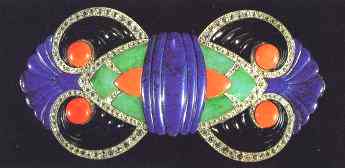 |
|
アフガニスタン産ラピスラズリの壺 |
ファベルジェ作 インペリアル・エッグ |
アールデコ・スタイルの花飾り 1931年頃 幅 10.7cm |
19世紀初頭にフランスでの化学合成によるウルトラマリンの発明により、ラピスラズリが絵画に使われるのは日本画のみになってしまいました。
しかし古来からのアフガニスタンに加えて、近年では新たにチリ等世界各地に新たな産地が発見されました。豊富な供給のおかげでラピスラズリはかつてのように権力者や大富豪だけが独占できる宝石ではなく、誰もが出ごろな値段で手に入れることが出来るようになりました。
加工用の原石なら、アフガニスタン産の最高級品の100g程度の石が数千円程度です。
このように手軽な宝石ですから、その価値は石そのものというより、加工の技術やデザインが決め手となります。
写真の壺は石なら何であれ彫りたくなる中国人の手になるものですが、さすが材料が最上のラピスラズリともなれば、腕の良い職人が丹精込めた見事な出来映えです。
次の卵は言わずと知れたファベルジェのインペリアルエッグです。
これ以上は望めない絶品のラピスラズリと精妙を極めた黄金の飾りのデザインと仕上げの見事さにはただただ感嘆するのみ。
3番目はアールデコスタイルのラピスラズリ、翡翠、珊瑚、黒瑪瑙をダイアモンドと白金で仕上げた花飾り、フランスの老舗の宝石店ブーシュロンの手になる傑作です。
Since synthetic ultramarine was developped in early 19th century, lapis-lazuli is no more employed as pigment except for Japanese paintings. And abundant supply by discovery of mines outside Afghanistan resulted in the dramatic change of status - Lapis-lazuli is no more a luxurious gemstone for limited rich class but became a gemstone affordable to everyboday.
The value of lapis-lazuli jewelry is determined not by stone quality only, but with design and skills of artisans.
Photo shows the most representing masterpieces of Chinese, Russian and French masterworks.